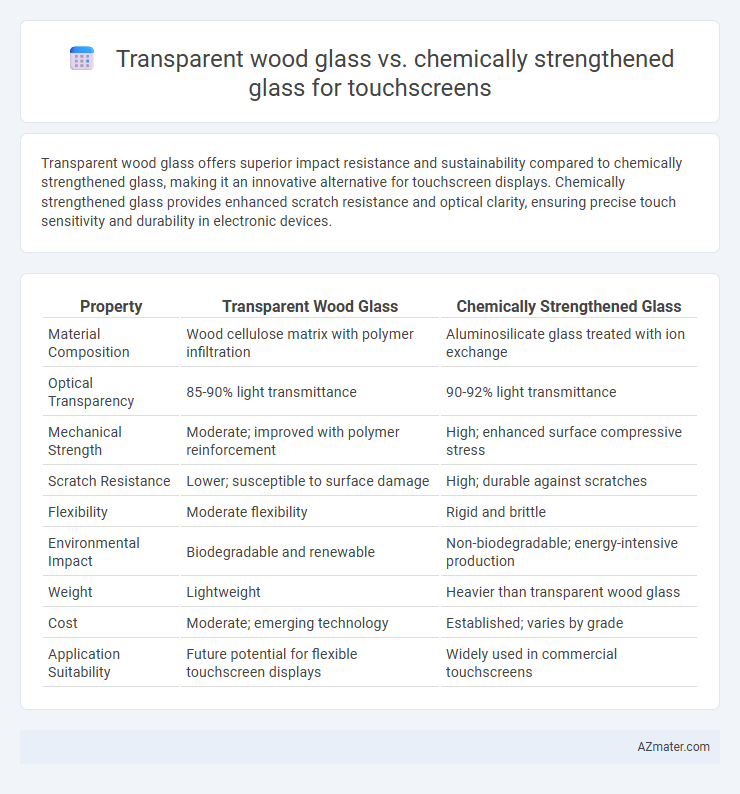Transparent wood glass offers superior impact resistance and sustainability compared to chemically strengthened glass, making it an innovative alternative for touchscreen displays. Chemically strengthened glass provides enhanced scratch resistance and optical clarity, ensuring precise touch sensitivity and durability in electronic devices.
Table of Comparison
| Property | Transparent Wood Glass | Chemically Strengthened Glass |
|---|---|---|
| Material Composition | Wood cellulose matrix with polymer infiltration | Aluminosilicate glass treated with ion exchange |
| Optical Transparency | 85-90% light transmittance | 90-92% light transmittance |
| Mechanical Strength | Moderate; improved with polymer reinforcement | High; enhanced surface compressive stress |
| Scratch Resistance | Lower; susceptible to surface damage | High; durable against scratches |
| Flexibility | Moderate flexibility | Rigid and brittle |
| Environmental Impact | Biodegradable and renewable | Non-biodegradable; energy-intensive production |
| Weight | Lightweight | Heavier than transparent wood glass |
| Cost | Moderate; emerging technology | Established; varies by grade |
| Application Suitability | Future potential for flexible touchscreen displays | Widely used in commercial touchscreens |
Overview of Transparent Wood Glass and Chemically Strengthened Glass
Transparent wood glass, developed by embedding cellulose nanofibers within a polymer matrix, offers high strength, lightweight properties, and biodegradability, making it a sustainable alternative for touchscreen applications. Chemically strengthened glass, such as Gorilla Glass, undergoes ion exchange processes to create a compressive surface layer, enhancing scratch resistance and durability under impact. Both materials provide optical clarity and robustness, but transparent wood glass excels in environmental sustainability while chemically strengthened glass remains the industry standard for high-performance touchscreen protection.
Material Composition and Manufacturing Processes
Transparent wood glass integrates cellulose nanofibers derived from lignin-stripped wood with transparent polymers through delignification and impregnation techniques, resulting in a composite that balances strength and flexibility. Chemically strengthened glass, such as Gorilla Glass, undergoes ion-exchange processes where smaller ions in the glass surface are replaced by larger potassium ions, creating compressive stress layers that enhance scratch resistance and durability. The manufacturing precision of chemically strengthened glass ensures uniform molecular reinforcement, whereas transparent wood glass relies on biomaterial engineering for eco-friendly, lightweight touchscreen substrates.
Optical Clarity and Transparency Comparison
Transparent wood glass exhibits a high degree of optical clarity with light transmittance rates typically around 85-90%, offering a warm, natural aesthetic while maintaining sufficient transparency for touchscreen applications. Chemically strengthened glass, such as Gorilla Glass, provides superior transparency with light transmittance exceeding 90%, delivering sharper visuals and more accurate color representation essential for high-performance touchscreens. The natural microstructure of transparent wood may cause slight diffusion and a softer light effect, whereas chemically strengthened glass ensures minimal distortion and maximum optical clarity under varied lighting conditions.
Mechanical Strength and Durability
Transparent wood glass exhibits superior mechanical strength due to its natural fiber-reinforced cellulose structure, offering enhanced impact resistance and flexibility compared to chemically strengthened glass. Chemically strengthened glass relies on ion-exchange processes to create a compressive surface layer, improving hardness and scratch resistance, but remains more brittle under extreme mechanical stress. In terms of durability, transparent wood glass demonstrates higher resistance to crack propagation and shattering, whereas chemically strengthened glass excels in maintaining transparency and surface smoothness under repeated touchscreen usage.
Touch Sensitivity and User Experience
Transparent wood glass offers enhanced touch sensitivity due to its natural microstructure, enabling faster response times and more accurate touch detection compared to chemically strengthened glass. Chemically strengthened glass provides high durability and scratch resistance but may slightly reduce touch responsiveness due to its denser surface layer. Users often experience smoother, more precise interactions with transparent wood glass, while chemically strengthened glass prioritizes robustness for heavy usage environments.
Environmental Impact and Sustainability
Transparent wood glass offers superior environmental benefits over chemically strengthened glass due to its renewable biomass origin and lower energy-intensive production processes. Chemically strengthened glass relies on energy-consuming ion exchange treatments and non-renewable silica sources, resulting in higher carbon emissions and waste generation. The biodegradability and potential for carbon sequestration in transparent wood glass make it a more sustainable choice for touchscreen applications.
Thermal and Chemical Resistance Properties
Transparent wood glass exhibits superior thermal insulation and resistance to chemical degradation compared to chemically strengthened glass, making it highly durable under extreme temperature fluctuations. Chemically strengthened glass, typically aluminosilicate-based, offers enhanced hardness and scratch resistance but is more susceptible to thermal shock and chemical etching. Both materials provide distinct advantages for touchscreen applications, with transparent wood glass excelling in maintaining integrity during thermal stress and chemically strengthened glass delivering robust surface protection.
Applications in Touchscreen Technology
Transparent wood glass offers enhanced flexibility and sustainability for touchscreen applications, making it ideal for flexible displays and foldable devices. Chemically strengthened glass provides superior hardness and scratch resistance, ensuring durability in smartphones, tablets, and kiosks. Both materials advance touchscreen technology by addressing specific needs for durability versus environmental impact and design innovation.
Cost-Effectiveness and Scalability
Transparent wood glass offers cost-effectiveness through lower raw material and manufacturing expenses compared to chemically strengthened glass, which depends on energy-intensive ion-exchange processes. Scalability favors transparent wood glass due to abundant natural resources and simpler fabrication techniques, while chemically strengthened glass requires specialized equipment and longer processing times limiting mass production flexibility. Cost reduction and scalable production scalability position transparent wood glass as a promising alternative for next-generation touchscreen technologies.
Future Trends and Innovations in Transparent Glass Materials
Transparent wood glass offers sustainable advantages with its lightweight, high strength, and excellent optical clarity, positioning it as a promising alternative to traditional chemically strengthened glass in touchscreen applications. Innovations in nanocellulose reinforcement and hybrid composites are pushing transparent wood glass towards improved durability and scratch resistance, narrowing the performance gap with chemically strengthened glass that remains dominant due to its superior hardness and established manufacturing processes. Future trends indicate a growing integration of transparent wood glass with flexible, biodegradable electronics, while chemically strengthened glass advances focus on enhancing impact resistance and ultra-thin design compatibility for next-generation touchscreens.

Infographic: Transparent wood glass vs Chemically strengthened glass for Touchscreen
 azmater.com
azmater.com